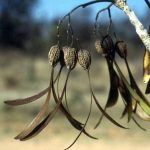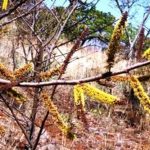TREE LIFE
July 1984
FORTHCOMING CALENDAR
Saturday July 7th : Botanic Garden Walk. Meet in the Car Park at 1045 for 1100 hours.
Sunday July 15th : We intend to spend the morning at Wolle Kirk’s Aldington Farm on the Marirangwe Road, Harare South which offers a mixed bag of woodland/stream vegetation. Tarchonanthus camphorates was one of the interesting finds here. In the afternoon we want to go out a little further to Dzumbumu dam, just inside the Purchase Area where Meg reports as an interesting spot with a colony of Euphorbia cooperi. A bus has been arranged at the not too exorbitant fare of $6.50 leaving the Monomatapa car park at 0830 hours.
MATABELELAND CALENDAR
Sunday July 1st : As advertised in the May Tree Life, we shall be going to the Matopos where we shall keep to the Circular Drive, down to Maleme, and return via Scenic Drive and Efifi. Meet at Dora Webb’s house, 6 Caithness Road, at 0830 hours where cars can be left in safety.
June meeting. We met members of the Aloe, Cactus and Succulent Society at Marbukuweni for the purpose of naming trees for them. The Tree Society has had several outings there in the past so it is well documented. Our “pupils” were very keen to learn and I hope derived some benefit from our efforts. They expressed the wish to have another combined meeting when the trees are more leafy, and I hope this can be arranged.
BOTANIC GARDEN WALK 2ND JUNE, 1984
On June 2nd members of the Tree Society were led by Tom Muller through that section of the National Botanic Gardens devoted to Low Altitude Rain Forest which is approx. below 1 000 ft (300 m), and has an annual rainfall of between 2 500 and 3 000 mm simulated in the Gardens by spray from boreholes. There are very few areas in Zimbabwe which naturally have such high rainfall, and these are nearly all confined to the Eastern Districts forests and especially to the Horoni-Rusitu forests situated at the southern end of the Chimanimani mountains between the Horoni and Mukurapini rivers. Here the altitude is below 300 m.
Of the many trees and lianes, woody climbers, amongst the rarest occurring in Zimbabwe is Ficus vallis choudae, MORACEAE, a huge fig tree of which not more than 15 to 20 are known to occur within our borders. This has large heart shaped to circular leaves. Next we looked at Pancovia golugensis, SAPINDACEAE, of which only one tree, in the Burma valley, is known, being a slender tree with alternate, compound, paripinnate leaves, bearing 3 to 4 pairs of leaflets up to 14 x 6 cm, the young leaflets being pink to red. Still within the SAPINDACEAE, Aporrhiza nitida has leaves with 2 to 4 pairs of opposite or sub-opposite leaflets, thick set petiolules, and fine grey bark with well spaced horizontal markings about 20 cm apart. Blighia unijugata, SAPINDACEAE, is not so rare but is confined to Eastern Districts forests kloofs and has similar leaves to Aporrhiza but more leathery. It is found on burial grounds left untouched in otherwise decimated areas, and also in Northern Zululand.
Within the SAPINDACEAE, a family with many forest representatives, was Afrosersalise?? are rare here but occurring in Mozambique forests. Its leaves are blue green in rosette formation, cf. Manilkara mochisia, multi trunked, and occurs in Horoni-Rusitu forests.
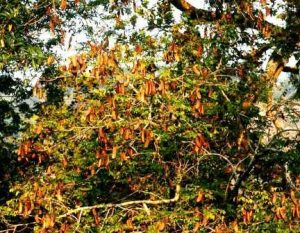
Erythrophloem suaveolens. Photo: Bart Wursten. Source: Flora of Zimbabwe
Erythrophleum suaveolens, CAESALPINIOIDEAE, occurs in riverine habitat in the Horoni-Rusitu and Pungwe valleys. It has hard heavy borer resistant wood containing a poisonous substance used at ordeal trials. It also occurs in Mozambique forests in woodlands in association with certain Brachystegias.
Amongst other lianes, some reaching up 30 m to the light at the tops of the trees we were shown Landophia kirkii, EUPHORBIACEAE, which has profuse milky sap and is the dominant forest ‘rope’. One other large rare liane also from the Horoni-Rusitu was Raphiostylis benensis of the family ICACINACEAE to which Apodytes dimidiata also belongs.
Maranthes goetzeniana, CHRYSOBALANACEAE,the same family as Parinari, is here a big forest tree with large simple leaves up to 15 x 5 cm with conspicuous drip tips at the leaf ends for rain to run off which is a characteristic of many forest trees.
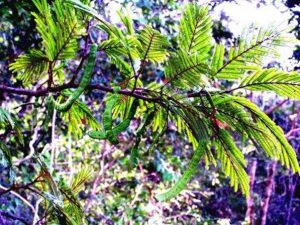
Newtonia buchananii,. Photo: Jos Stevens. Source: Flora of Zimbabwe
Cryptocarya liebertiana is a big forest tree with large, simple alternate leaves. It belongs to LAURACEAE to which also belongs the exotic Avocado pear and Cape stinkwood Ocotea bullata. Amidst all these strange trees unknown to most of us it was nice to recognize Newtonia buchananii, MIMOSOIDIAE, with its beautiful finely divided compound, bipinnate leaves and pods with winged seeds, and also Khaya nyasica, MELIACEAE, the ‘big tree’ of Chirinda forest, and riverine habitat. This Newtonia, the forest Newtonia, occurs along the Pungwe river and in the Honde Valley. The Khaya is more widely distributed to various parts of Zimbabwe. It grows into a magnificent tree with an erect straight trunk and enormous leafy crown, evergreen with somewhat blue grey bark, smooth, but blotchy.
Croton sylvaticus, EUPHORBIACEAE, is widely distributed in terms of altitude. It has alternate lanceolate to ovate leaves with paired glands at the leaf base, a characteristic of all true Crotons. There is a large one at Ewanrigg gardens behind the Barberton daisies. The fruit consists of bunches of cinnamon coloured clusters of capsule fruits, 8 to 10 mm in diameter. This tree, according to Tom has a distinct aromatic smell from just below the bark – if one were to slash it that is
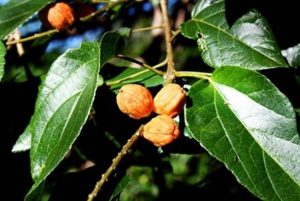
Croton sylvaticus. Photo: Mark Hyde. Source: Flora of Zimbabwe
Of the RUBIACEAE family, which is well represented in many forest areas we only saw Aidia micrantha belonging in the Newtonia under storey. It is a large shrub with a tendency to scramble with small creamy white, sweet scented flowers in axillary heads.
Rinorea ilicifolia is a rare tree in the Violet family, VIOLACEAE, which is only known here from the Horoni forest. Its leaves are simple, alternate, with a spiny margin. The flowers are yellow, sweetly scented on a small tree or shrub.
Voacanga schweinfurthii, APOCYANACEAE, the Oleander family, has large, simple opposite, paired leaves, with paired fruits joined at the base, up to 5 cm in diameter. It is a forest understory tree occurring in the Mozambique and was only recently identified in Zimbabwe in December, 1983.
Lastly, also a great rarity, we were shown a Dwarf Tree Fern Cyathea madagascariensis, on 25 to 35 cm high with a distinct tiny trunk, growing on the lip of a shady stream. It is found naturally along the Makarubeni river.
All these trees and plants, seldom seen and scarcely known of in the greater part of Zimbabwe, have been collected from their natural surroundings by Tom Muller or grown from seed he has collected and grown in the National Botanic Gardens which are rightly the pride of his heart.
Many thanks to Tom for a most interesting morning.
-G. Masterson
And many thanks to Gill for standing in for Kim for this write up, while he is busy jollying in Europe. More of that subject in the next Tree Life!
OUTING TO MAKOMORARA, RUWA, SUNDAY 17TH JUNE 1984
We are very grateful to Bruce and Margaret Underwood who, uncomplaining, allowed us to invade their lovely property near Ruwa Club for our June outing. It was very gratifying to see a good turnout of members although there was no bus. We are particularly pleased to see a large contingent from Borradaile, Marondera, on the one hand and from Old Mazowe Road on the other.
After the usual greeting ceremonies and chin-wags the party set off into the bush below the house towards the railway line. Having already driven in under a canopy of Parinari curatellifolia, it was appropriate that we stopped first to look at this close up. We noted the short fat petiole carrying the alternately arranged simple leaves, the veins of which are so straight and parallel, coming out from the midrib almost at right angles. Meg Coates Palgrave pointed out the presence of tiny glands on the petioles, which I had never noticed before. Perhaps these might account for the occasionally unpleasant smell for which these trees are notorious. On much of the property, the Parinaris formed a closed canopy which is, I think, rather unusual and was pleasant to experience. On nearly all the Parinaris were the epiphytic orchids which lend their name to the property.
Moving on we took a look at the cabbage tree Cussonia arborea with its large digitately compound leaves which were just starting to turn yellow prior to falling. The flower remains were recovered below on the ground to demonstrate the octopus like flower heads.
Close to this was a large specimen of Burkea africana, the mukaratior caterpillar tree. The leaves are bi-pinnately compound. The pinnae are arranged in opposite fashion but upon these the actual leaflets (pinnules) are alternately arranged. These points serve to confirm identification which will already be 90% sure from the velvety russet growing tips of the branchlets.
In the woodland we soon came across the first of many Ekebergia benguelensis characterized by the reddish petiole and rachis and often the ends of the branchlets. Some had started to turn into their rich autumn colours.
We were able to contrast Pavetta schumanniana with P.gardeniifolia, the two members of the RUBIACEAE with black bacteria nodules in the leaves. The former has furry “quilted” leaves and inhabits the open woodland, while the latter has a glabrous, smooth leaf and prefers the shade. Many of the ones we saw during the day were in fruit, clusters of little black berries.
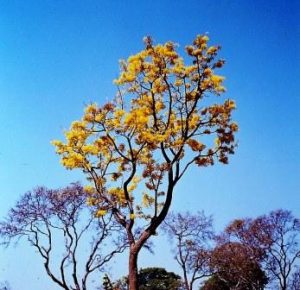
Ochna schweinfurthiana. Photo: Mike Bingham. Source: Flora of Zimbabwe
In the understory below the Parinaris, we found Ochna schweinfurthiana, followed soon after by Ochna puberula. O. schweinfurthiana has the largest leaves of the common Ochnas. The margins are strongly serrated. O. puberula is similar but with small leaves. In the afternoon we also saw O. pulchra which has medium sized leaves with very fine serrations. The bark on the upper parts tends to flake off revealing the smooth pale under bark earning it the nickname mermaid tree, being smooth above and scaly below. All the Ochnas seem to have the same sort of terminal bud.
In the same grove were plenty of Grewia decemovulata. Notable features were their small stature, the single lobed orange fruit, the non-square stem, leaves not bi-coloured, and being almost symmetrical are broadest across the middle.
Moving out into the open onto something of a vlei we encountered in the first place Maytenus senegalensis in flower. There was no “carpet or confetti” on the ground below from the fallen petals although one member confirmed having observed this phenomenon once this season. Out on the vlei proper were many Syzygium guineense. These invariably bear the strange growth or diseased flowers looking like an untidy upside down tassel. This, if dipped in boiling water is supposed to yield a local “tea”, hence “African tea bag”. However, another enterprising member tried it at lunchtime and I had to agree that it tasted like nothing more than boiled water. Under the Syzygiums we noted young bushes of Maesa lanceolata, sometimes almost forming a circle around the tree. This presence is perhaps the result of bird born seeds, combined with a suitable shady habitat.
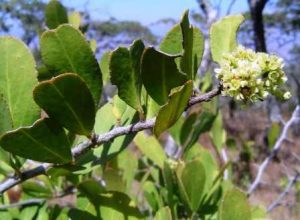
Maytenus senegalensis. Photo: Bart Wursten. Source: Flora of Zimbabwe
On the other side of the vlei we stopped to look at Protea gaguedi with its glabrous lanceolate leaves. Later during the day we saw P. welwitschii with similar lanceolate leaves but which are velvety in texture and later, we also saw P. angolensis with much broader leaves with a pink “petiole”. We saw two in flower the scent of which has a nauseating sickly sweet character.
At the edge of the rocky area was a big tree which had us guessing for a while. This turned out to be Swartzia madagascariensis. The abnormal size was I think the main stumbling block to identification although some rotting “snake bean” pods on the ground finally clinched the matter. This specimen had no pods on the tree, yet the specimen seen in the afternoon, also a respectable individual, was festooned with pods.
Also at the edge of the rocks were two adjacent Erythrina abyssinica, remarkable for their entirely different bark, the one with deeply longitudinally fissured bark, and the other’s consisting of projecting ‘bosses’.
We proceeded around to the back of some rocks to examine the impressive roots of a Celtis africana wedged into and draped over the boulders. The fresh green leaves up above were delightful to behold.
During the morning the usual problems of identification of Vangueria infausta and Vangueriopsis lanciflora had arisen. However, Meg pointed out a possible guide, namely, that Vangueria almost invariably has a nodular infestation of some sort in some of the leaves, something which is absent in Vangueriopsis. We will try this in future.
We moved out of the main area of rocks to a small clump of rocks to one side which was the home of that extraordinary Bequaertiodendron magalismontanum. This was large, though not tall. The original large trunk had been supplemented by a number of smaller side trunks so that the result was a large spreading tree. The developing fruit was noted, growing on the actual branches as opposed to the more conventional placing at the ends of the branches. The vlei, combined with rocks and a termite colony probably explains the unusual situation of this tree, more often encountered along river banks.
Skirting around the rocks on the vlei edge we looked back to see a picture. On a red lichen granite face a small Ficus thonningii was spread eagled clinging on with roots aligned with the horizontal fissures. The effect was most pleasing to the eye and camera lens.
After lunch on the still green Kikuyu lawn fronting the house, under a grove of Parinaris, we went onto the higher ground above the house. What stands out in my mind were the many flowering Loranthus sp. parasites in a number of trees. The bright red ‘match stick’ flowers look almost luminous. Parasites though they may be, I would not mind one or two in my garden.
The little grove or multi trunked specimen of Peltophorum africanum situated near the fence was charming. It must also have been ancient. We came across Flacourtia indica in this area. This is not uncommon, but for once there was fruit on the tree and it was possible to show the asymmetric or lopsided fruit, such that the ‘end’ of the fruit emerges to one side and not at the top if one follows the line of the stalk. Also fruiting heavily and magnificent as seen from a distance was a tall and mature Terminalia sericea. Yet another tree in fruit was a small Securidaca longepedunculata, violet tree, next to the driveway. The winged seeds were not yet ripe and had not yet fallen.
At the end of the day yet again reflecting upon the amazing variety of trees seen and also the presence of some impressive individual specimens. All this within 15 minutes of town.
Our sincere thanks go to Bruce and Margaret for so kindly allowing us to explore Makomorara.
- J. P. Haxen
PHILIP HAXEN, CHAIRMAN


